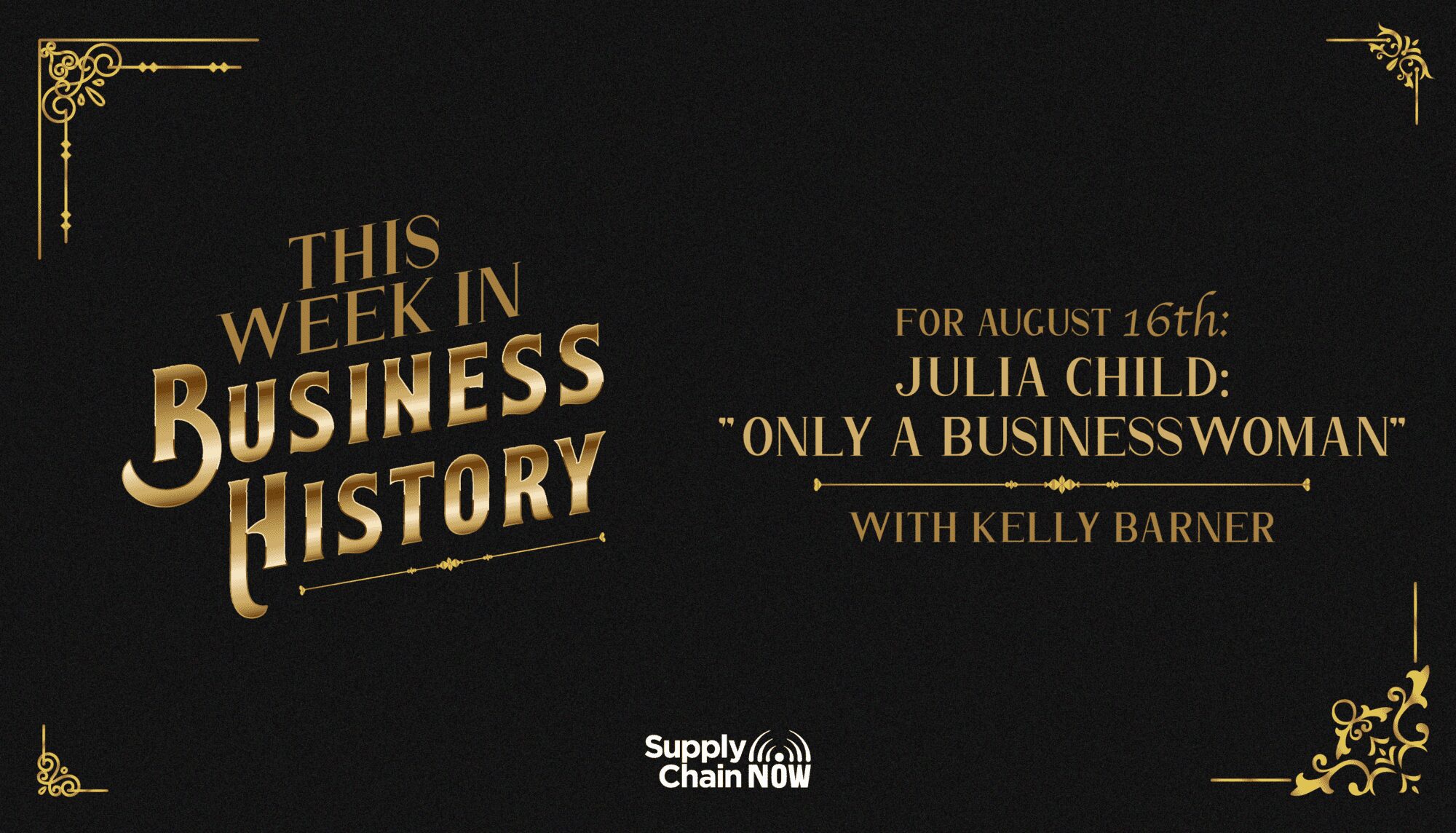Intro/Outro (00:12):
Good morning, Scott Luton here with you on this edition of this week in business history. Welcome to today’s show on this program, which is part of the supply chain. Now family of programming. We take a look back at the upcoming week, and then we share some of the most relevant events and milestones from years past, of course, mostly business focused with a little dab global supply chain. And occasionally we might just throw in a good story outside of our primary realm. So I invite you to join me on this. Look back in history, to identify some of the most significant leaders, companies innovations, and perhaps lessons learned in our collective business journey. Now let’s dive in to this week in business history,
Kelly Barner (01:13):
W GBH is the Boston affiliate of the public broadcasting service or PBS. It was a very important part of my childhood because that’s where Mr. Rogers and my friends from Sesame street lived. Now, I’m old enough to admit that we had no choice, but to watch our TV live. So you always caught a bit of the program that was on before or after the show you wanted to watch. Even as a five year old, I knew Bob Vila from this old house. I watched Bob Ross paint, his happy little accidents and fluffy clouds. And I watched Julia child prepare, elaborate French dishes in a cheerful looking kitchen. Maybe I was destined to work in audio even back then, but my memories of Julia child are actually more of her voice than anything else. She had a very distinctive sound and I would venture to guess that I’m not the only one of us that can still hear her voice in my mind.
Kelly Barner (02:15):
Even now, Julia child was born on August 15th, 1912 in Pasadena, California. She was the first woman to have her own cooking show on TV. And while that is impressive, I think you’ll be amazed to hear the broad range of skills and experiences she had during her life. So many that I can’t possibly cover them all here. One of her cookbook, collaborators and a fellow chef Simone Beck called child only a businesswoman during a time in their lives when they were not close. Spend a few minutes with me. And I think you will discover that she was a very effective business woman and far more as well.
Kelly Barner (03:05):
I’m Kelly Barner your host for this episode of this week in business history, on supply chain now, and I love history. I’ll be honest though. I’m not all that familiar with French cuisine despite growing up during Julia child’s heyday, but I can appreciate a life well lived, and there is nothing more rewarding than rediscovering stories that have been forgotten. If you enjoy the unique blend of storytelling and business history that Scott Luton and I share on this week in business history, please take a minute to subscribe to the podcast and share a review that will help others find us. And now back to this week’s business history story, the life’s work of Julia child as a young girl in California, Julia child was described by a friend as really, really wild. Maybe she was just too big for the life she was living. And I don’t just mean because she was six foot, two inches tall after getting off to a slow start as a failed writer and advertising professional, her desire for adventure finally took over.
Kelly Barner (04:21):
She wanted to join the military, but they said she was too tall. So instead Julia volunteered with the American red cross in Pasadena, heading up the department of stenographic services and working in the aircraft warning service. When Pearl Harbor was bombed on December 7th, 1941, she traveled to Washington DC and joined the office of strategic service. The United States intelligence service reporting to the joint chiefs of staff. She volunteered to serve abroad and her travels took her to China Colombo and Sri Lanka, where she helped develop shark repellent as part of the emergency sea rescue equipment section. This is also where she met her future husband, Paul child, and OSS officer. It was decidedly not love at first sight. Paul had a twin brother named Charlie that he wrote to about Julia calling her wildly emotional and a sloppy thinker. Maybe it was something in the air, but they were dating about a year later and married a year after that, after the war, Paul worked with the us information service and in 1948, they were stationed in France where Julia would meet French cooking.
Kelly Barner (05:46):
Now, if you haven’t been tracking dates in your mind, you might be surprised by this fact, Julia child didn’t graduate cooking school until she was 40 years old. She attended Lako and blue cooking school in Paris and took private lessons with master chef max Bunard during her six months of training, she also formed connections with Louis set, Bela and Simone Beck. Two of her fellow cord on blue students. And they created the Nicole de talkand, which translates to mean the school of three gluts, or maybe more nicely put three greedy hungry people after struggling to find her professional calling Julia child was finally thriving. She studied the French language and spent her free time browsing open air farmers markets just to speak with people in practice. And her timing was perfect with us service members returning home after world war II, with the taste for French cooking, there was a lot of interest in French cookbooks and instruction.
Kelly Barner (06:59):
The tomans also wrote a groundbreaking cookbook titled mastering the art of French cooking, which is mercifully in English. The first volume was published in September of 1961 and the second in 1970, ironically Houghton Mifflin, the first publisher rejected it saying that Americans did not want an encyclopedia. They wanted an easy way to cook something French fast, but their loss would become Alfred a KNS game. It topped the lists of best selling cookbooks for five years after being published and led Julia to write many more cookbooks, including my life in France, which was published by her nephew after she passed away, the original cookbook was special because of the French American collaboration that brought it to life. Julia child would check to make sure that specific ingredients were available in American supermarkets. And if they were not, she would experiment until she found an acceptable alternative.
Kelly Barner (08:06):
Even then an American taste for French food was not enough to keep mastering the art of French cooking at the top of the best sellers list. That was another still to be discovered, talent of Julia Childs. The art of self-promotion Julia was invited on a Boston PBS show called I’ve been reading to promote her cookbook. And the producers suggested that she demonstrate how to make an omelet. 27 viewers rode into the station asking for more, which took far more of a commitment back then than sending an email or making a Facebook post today. And a pilot was ordered between 1962 and 19 73, 199. Episodes of the French chef were broadcast for the first 26 segments. She only made $50 a piece. Julia child made French cuisine accessible to her viewers and they loved her for it. Here’s something else about her that I relate to. It took an estimated 19 hours of prep for each 30 minute cooking segment.
Kelly Barner (09:18):
That reminds me more than I’d like to admit to what it’s like to get dial P in this week in business history, ready to pop broadcast. By the end of 1965, her show, the French chef was being carried by 96 PBS stations. I’ve already mentioned that Julia child was the first woman to have her own cooking show, but the French chef was also the first show to be made accessible to deaf and heart of hearing viewers through the use of captions. She has also been credited with creating the how to, or DIY genre of television, something that has exploded into many channels and shows today. And Julia’s entrepreneurial streak wasn’t over yet either when her friend James Beard known as the Dean of American cookery died on January 21st, 1985, Julia child suggested that his New York brownstone, which was owned by Reed college in Portland, Oregon be turned into something special. A fundraiser was held and his home became the James Beard foundation, an organization with a mission quote, to provide a center for the culinary arts and to continue to foster the interest. James Beard inspired in all aspects of food, it’s presentation preparation, and of course, enjoyment in the early two thousands, poor management and fraud on the part of the board of the James Beard foundation nearly brought the organization to an end, but as it turned out, it was his former home. The one Julia child suggested saving that turned around and saved the foundation by being so valuable.
Kelly Barner (11:07):
Julia child spent the latter part of her career cooking and doing new shows, taking in a special interest in children’s nutrition and worrying about people getting overly focused on keeping cream and butter out of their diet. Here is a quote from her that I just love. That comes from an interview in the 1990s. Everybody is overreacting. If fear of food continues, it will be the death of astronomy in the United States. Fortunately, the French don’t suffer from the same hysteria we do. We should enjoy food and have fun. It is one of the simplest and nicest pleasures in life.
Kelly Barner (11:50):
Julia child passed away from kidney failure on 14th, 2004, just shy of her 92nd birthday. And her last meal was homemade. French onion soup. The accolades began to pour in from all over the world. Her director and producer Jeffrey Drummond said, quote, I think the secret of her appeal was a combination of joy in what she was doing and a deep desire to teach and to teach well food network, president Brooke Johnson said she was more than a pioneer, a legend or a giant she’s the rock that started the avalanche that changed the way America eats and an NPR article said she helped elevate the nation’s culinary standards. She actually elevated all kinds of standards at the time of her passing. Julia child’s net worth was 50 million. According to celebrity, net worth.com, which puts that $50 per cooking segment into perspective. She was a breast cancer survivor, something she only rarely talked about.
Kelly Barner (13:04):
She was the first woman to be inducted into the culinary Institute of America’s hall of fame. President George W. Bush presented her with the presidential medal of freedom and the French government gave her the Legion of honor for promoting American appreciation and techniques for French cooking. She won a primetime Emmy award, two daytime, Emmy awards, and a Peabody award for her show. The French chef, her kitchen and kitchen tools are now in the Smithsonian museum of natural history. And this was the actual working kitchen from her home in Cambridge, Massachusetts. And to think she never graduated from cooking school until age 40 Bon a petite Julia child. I propose that in her honor, we all try to enjoy our food and have a little fun on that note. It is time to wrap up this edition of this week in business history. Thank you so much for tuning into the show each week.
Kelly Barner (14:12):
Don’t forget to check out the wide variety of industry thought leadership available@supplychainnow.com. As a friendly reminder, you can find this week in business history, wherever you get your podcast from and be sure to tell us what you think we would love to earn your review. And we encourage you to subscribe so that you never miss an episode on behalf of the entire team here at this week in business history and supply chain. Now this is Kelly Barner wishing you all, nothing but the best. We’ll see you here next time on this week in business history,



